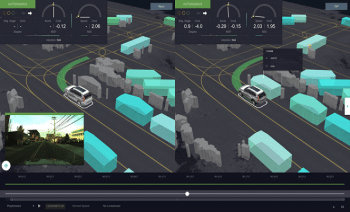Autonomous Visualization System can display an autonomous vehicle’s performance in the real-world. Several other companies, including Voyage and Applied Intuition, have pledged to use it.

Uber on Tuesday announced that it is open sourcing its Autonomous Visualization System (AVS), which it describes as “a new way” to understand and share autonomous systems data.
“AVS is a new standard for describing and visualizing autonomous vehicle perception, motion, and planning data, offering a powerful web-based toolkit to build applications for exploring, interacting and, most critically, making important development decisions with that data,” Uber wrote in a blog post.
“As a stand-alone, standardized visualization layer, AVS frees developers from having to build custom visualization software for their autonomous vehicles. With AVS abstracting visualization, developers can focus on core autonomy capabilities for drive systems, remote assistance, mapping, and simulation,” it added.
The Advanced Technologies Group (ATG) and Visualization teams at Uber have already leveraged AVS to support an ever-growing pool of autonomous use cases, such as root cause analysis, web-based log-viewing, developer environments, and mapping maintenance.
Now, several other companies, including Voyage and Applied Intuition, have also pledged to use it.
What set AVS apart from current solutions?
The company says AVS’ architecture distinguishes itself from current solutions.
- It was designed with an intentional separation of data from any underlying platform.
- Its limited, small specifications make tools easier to develop.
- Its data format requirements result in fast transfer and processing
AVS was created to meet the needs of everyone in the autonomy ecosystem, including engineers, vehicle operators, analysts, and specialist developers.
“Autonomous engineers can describe their systems with XVIZ easily, and then test and visualize their expectations with limited overhead. Specialist developers can quickly build data source-agnostic applications with strong performance characteristics and simplified integration using streetscape.gl. Lastly, operators can view the data in standard visual formats, including videos, across multiple applications, leading to easier collaboration, knowledge understanding, deeper analysis, and overall trust in the data quality,” the company explained.
Uber’s Future Plans
Uber plans to enhance the product with more data sources and specifications (especially ROS support), performance optimizations, and richer features such as side-by-side comparisons in collaboration with partners like Voyage, Applied Intuition, contributors, and open source foundations.
By open-sourcing the technology, the company hopes that developers in other nascent and adjacent industries, such as drones, robotics, trucking, fleet management, augmented and virtual reality, and retail, will find applications for this toolkit.
The company believes that an open data and tools strategy can help governments, developers, researchers, and the overall industry accelerate towards a smarter transportation ecosystem for the future.












































































